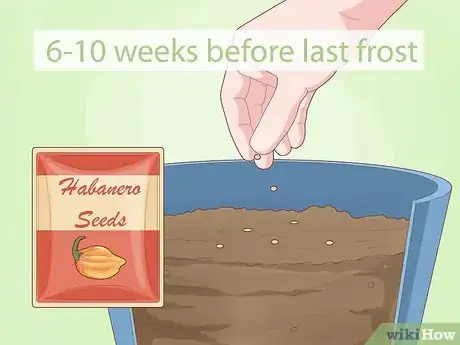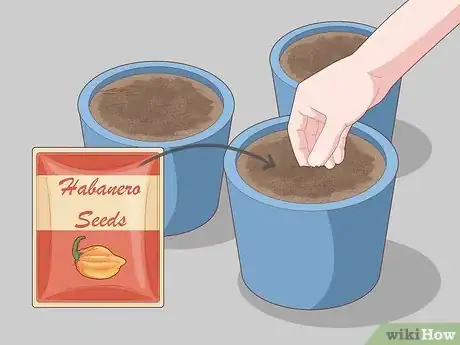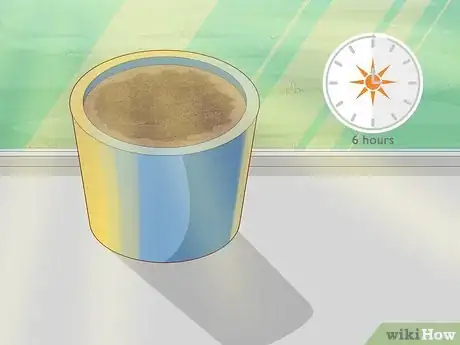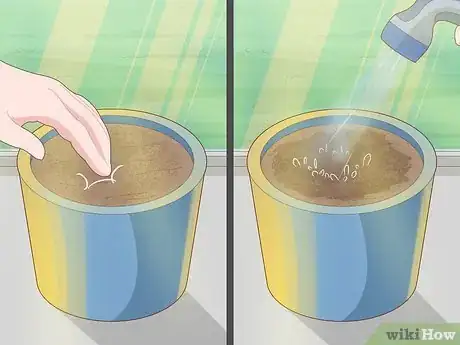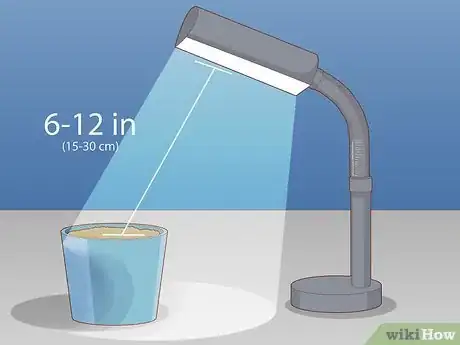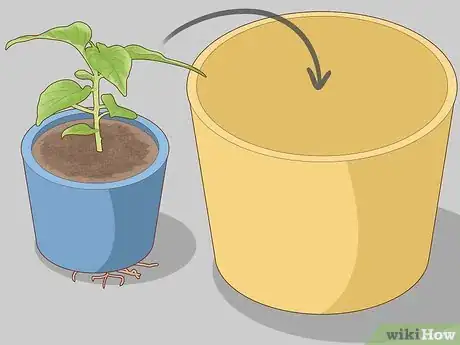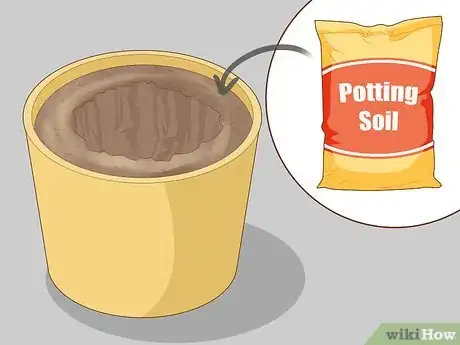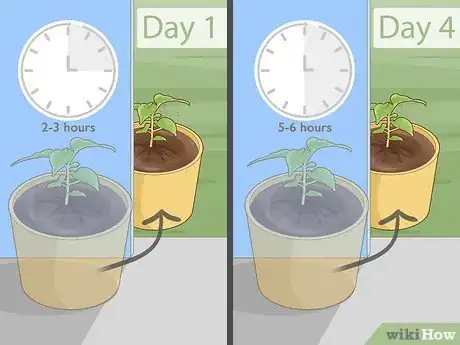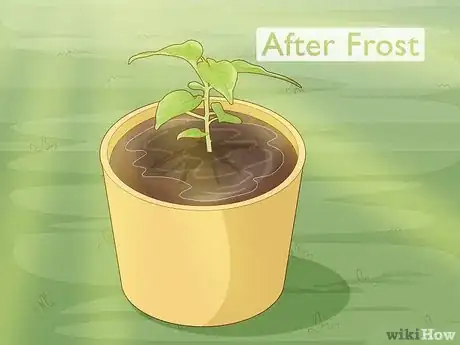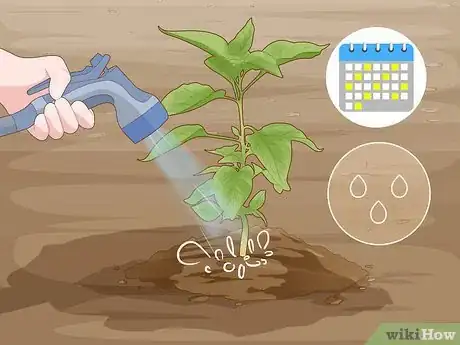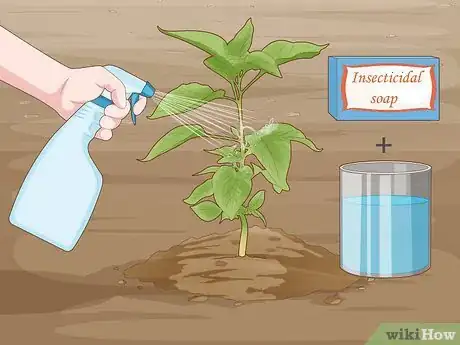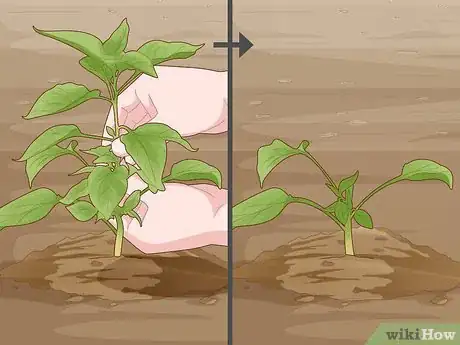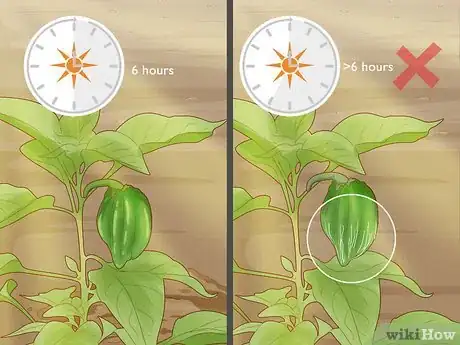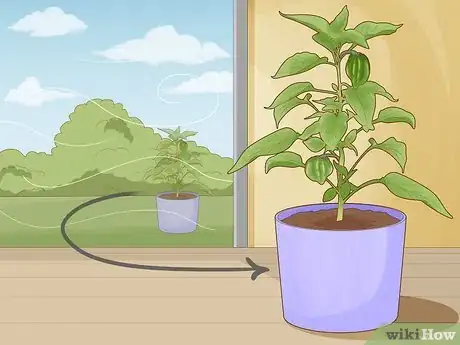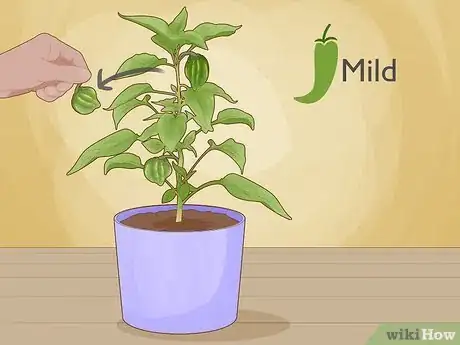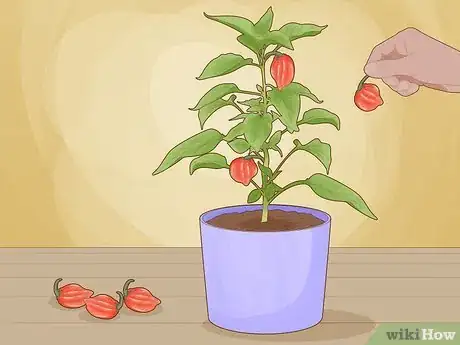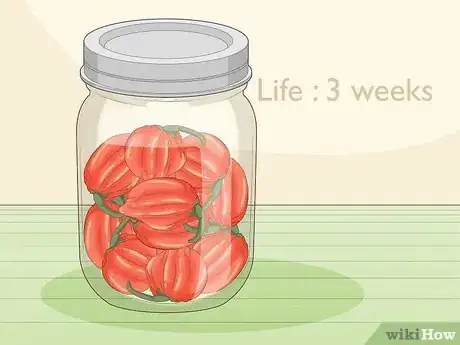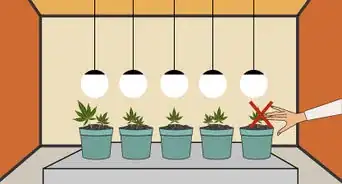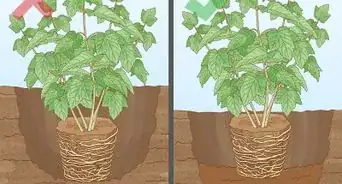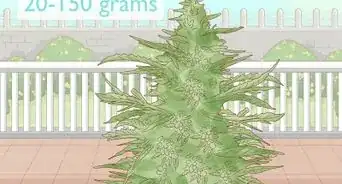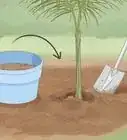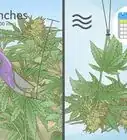This article was co-authored by wikiHow Staff. Our trained team of editors and researchers validate articles for accuracy and comprehensiveness. wikiHow's Content Management Team carefully monitors the work from our editorial staff to ensure that each article is backed by trusted research and meets our high quality standards.
This article has been viewed 11,992 times.
Learn more...
Habaneros are chili peppers known for their heat. They come in lots of different colors, from orange to purple, green to brown, and oftentimes their color tells you how spicy they are. Habaneros are pretty easy to grow no matter where you live. All you need are the seeds and a few basic gardening supplies. Within about 3 months, you'll have fresh habaneros!
Steps
Planting the Seeds
-
1Plant habanero seeds indoors 6-10 weeks before the last frost. Unless you live near the equator, your climate likely isn’t able to grow habanero plants from seeds outside. Start your seeds inside where the temperature is more controlled, planting them at least 6 weeks before the first frost of the season.[1]
- Look for the seeds at your local gardening store or from a reputable online source.
-
2Fill a container with well-draining, moist soil. Choose a container that’s roughly 5 inches (13 cm) wide and place small rocks at the bottom of the container to help with the drainage. Fill it with organic potting soil that’s labeled as “well-draining” or “loamy,” meaning the soil has a mix of sand, silt, and clay. Dampen the soil by holding the container under running water and let the excess water drain out.[2]
- Check to be sure your plastic or clay pot has holes in it for draining.
- Add a compost to your soil to make it super nutrient-rich.
Advertisement -
3Place a seed in the center of each container that you've prepared. Use your finger to push the seed down lightly into the soil so it's not just resting on the top. If you're worried about the seed sprouting, press 2 seeds down in each container, spacing them at least 4 in (10 cm) apart.[3]
- Avoid pushing the seeds too far down in the soil—place them deep enough so that they’re barely covered by the soil.
- If both seeds sprout, you'll need to separate the plants into different pots so they have enough room to continue growing.
-
4Put the container in a spot that gets at least 6 hours of sunlight daily. If you have a big that gets lots of morning and early afternoon sunlight, this is the perfect spot. Find the area that gets the most sunlight each day and place your container in this location to make sure the habanero grows.[4]
-
5Water the seeds whenever the top of the soil is dry. After you've planted the seeds, it's still important not to give them too much water so they'll grow properly. Touch the soil each morning to see if it's dry, and if it is, saturate the soil thoroughly to be sure the water gets all the way to the bottom of the plant.[5]
- Watering the seeds in the morning is best so that they'll be hydrated during the hottest part of the day.
-
6Heat the seedlings using a plant light or propagation mat to help them grow. Even if you have a sunny window, extra light and heat will help habanero seeds grow faster and stronger. Purchase a clip-on plant light or set your container on a heated mat to help the seeds germinate and grow better.[6]
- Keep the plant 6–12 in (15–30 cm) away from the light, depending on how strong it is and whether it emits a lot of heat.
- If you’re mainly using an artificial light for your plants, keep the light on for 16 hours a day or more.
Transplanting the Plant
-
1Move the habanero plant to a larger pot when it has 6-8 leaves. This is often when your plant’s roots have outgrown its pot. Once the habanero has about 8 leaves, it’s time to take the root clump out of its current container and move it into a larger one.[7]
- For example, if it’s currently in a pot that’s 5 in (13 cm) wide, you might transfer it into a new one that’s 10 in (25 cm) wide.
- This will take about 40 days once the seed is planted.
-
2Fill a larger pot with potting soil and dig a hole for the roots. Place loamy, well-draining potting soil into the new pot, filling it up about halfway. Create a hole in the soil big enough for the root clump to fit, estimating its size if needed.[8]
-
3Place the plant in the new pot and add more soil on top of the roots. Set the root ball down in the new soil, making sure it’s deep enough that the bottom of the stems are near the top of the pot. Sprinkle more potting soil into the pot, filling in any gaps and the sides of the root ball.[9]
-
4Water the plant thoroughly so the new soil is damp. Fill a cup with water and water the base of the plant, saturating the soil so it’s super damp. Let the excess water drain out of the bottom of the pot so the roots don’t stay soggy.[10]
- The water will help compact the soil. If it presses it down a lot, add a little more soil to the pot.
-
5Transition the plant to the outdoors slowly so it can adjust. Instead of immediately putting the habanero plant outside, put it out for a couple of hours one day, and then a few more hours a couple of days later, and so on until the plant is fully adjusted. This will make sure that your habanero transitions well from indoors to outdoors.[11]
-
6Put the plant outside permanently once the frost has ended. Only set your habanero plant outside after there’s no threat of frost and the weather has gotten warmer. Place your plant outside in an area that gets a lot of access to morning sun when it’s fully adjusted.[12]
-
7Transplant the peppers to a garden if you have the right growing conditions. If you want your habanero plant in your garden instead of in a pot, locate a spot that's sunny the majority of the day and dig a hole that's a little bigger than the plant's root ball using a shovel. Place the root ball in the hole in your garden and fill in any gaps with fresh soil. Give the plant a good watering and be sure to check on it every day or two to ensure it's not too dry.[13]
Keeping the Peppers Healthy
-
1Wait to water the soil until it dries out completely to avoid soggy roots. This is usually every 2-3 days if the plant is getting lots of sunlight. When you touch the soil and it’s dry, water the plant thoroughly by soaking it and letting the excess water drain out.[14]
- Overwatering your habanero can lead to the plant getting diseases or tasting super bitter.
-
2Fertilize your habanero once it’s 6 weeks old. After about a month and a half, your plant is mature enough to handle fertilizer. Choose a fertilizer that doesn’t have too much nitrogen and that’s organic. Follow the instructions on the fertilizer so you know how often to give it to the habanero as well as how much to use.[15]
- Try using 11-3-8 mix fertilizer on your habanero.
- Some fertilizers recommend that you use them once every 2 weeks.
-
3Get rid of pests on your outdoor plant using an insecticidal soap. Most pests don’t tend to go towards habanero plants, but if you do see some bugs on your plant, apply an insecticidal soap to help get rid of them. Another option is spraying the plant with a hose to wash the bugs off.[16]
- Purchase an insecticidal soap at your local home improvement or gardening store.
- Insecticidal soaps won't harm you or most animals if it's ingested (but you should wash off your peppers with clean water once you pick them!).
-
4Prune the shoots if you want a bushier habanero plant. Pruning your habanero plant isn’t required, but it’s a good way to give your plant a fuller shape while encouraging pepper production. Trim the shoots where the leaves begin to branch out using a pair of gardening shears or clean scissors right at the base of the node.[17]
- The node is the part of the plant where the leaves, stems, or flowers sprout and grow.
- Use your fingers to pinch off the flowers so the plant focuses its energy on the peppers.
-
5Check your peppers for signs of splitting apart due to too much sun. While habanero plants love sunlight and thrive in it, too much direct harsh sunlight can cause sunscald, which is essentially when the plant gets burned. Sunscald is when the peppers start to split due to the heat.[18]
- Most plants that are getting at least 6 hours of normal sunlight each day will be okay.
- Your plant’s leaves will help protect the fruit from sunscald.
-
6Bring your habanero plant indoors once the weather turns cold. Your plant won’t last outdoors in the cold weather. To preserve it, bring it inside easily if it’s already in a pot or fill a pot with soil and dig up the roots carefully to bring your habanero plant indoors if it was in the ground.[19]
- During the colder months, you won’t need to water your habanero plant as much.
Harvesting and Storing the Habanero
-
1Pick the fruits when they’re green if you want a mild habanero pepper. Habanero peppers can be picked as soon as they’re ripe and turn green. Green habanero peppers have a bit of spice but are still considered mild. Pull the green peppers off of the plant using your fingers to harvest them easily.[20]
- Your habanero peppers should turn green and be ready for picking about 75 days after you plant the seeds.
-
2Wait for the peppers to turn orange or red for spicier ones. Though different kinds of peppers will turn different colors when they're spicy, for many peppers, the darker red the pepper, the spicier it will be. Pluck orange peppers off of the plant for spicy ones or wait until they turn red for even spicier peppers. Use your fingers to pull them off of the plant gently.[21]
- When the peppers are ripe, they’ll come off of the plant easily.
- The peppers will turn orange and red roughly 90 days after you plant the seeds.
-
3Harvest your habanero before the cool weather comes if they’re outside. Pluck all of your peppers off of the plant while the weather is still warm. Once it gets colder outside, the cold and frost can cause the plant to wilt or die, ruining your peppers.[22]
- If you’re growing your peppers indoors and are using plant lights, you can wait longer to pick the peppers if you’d like.
-
4Store your habanero in a dry spot for roughly 3 weeks to save it for later. If you want to store the peppers after you pick them, place them in a sealed container and place them in a spot that’s cool and dry, like your pantry or on a shelf. You can also dry peppers using a dehydrator or oven on low heat and store them out on the counter.[23]
- The peppers will last up to 3 weeks before they start to spoil in a container.
- It’s also possible to freeze the peppers and store them for several months in the freezer.
Warnings
- Avoid starting your seeds outside because it'll be much harder for them to grow and thrive in unpredictable weather.⧼thumbs_response⧽
References
- ↑ https://www.gardeningchannel.com/how-to-grow-habanero-peppers/
- ↑ http://www.theindoorgardens.com/growing-habanero-peppers-indoors/
- ↑ https://peppergeek.com/how-to-grow-habaneros/
- ↑ https://sustainablefoodcenter.org/latest/gardening/everything-you-need-to-know-about-peppers-a-recipe
- ↑ https://peppergeek.com/how-to-grow-habaneros/
- ↑ https://peppergeek.com/how-to-grow-habaneros/
- ↑ https://www.gardeningchannel.com/how-to-grow-habanero-peppers/
- ↑ https://peppergeek.com/how-to-grow-habaneros/
- ↑ https://peppergeek.com/how-to-grow-habaneros/
- ↑ https://peppergeek.com/how-to-grow-habaneros/
- ↑ https://www.gardeningchannel.com/how-to-grow-habanero-peppers/
- ↑ https://www.gardeningchannel.com/how-to-grow-habanero-peppers/
- ↑ https://www.gardeningchannel.com/how-to-grow-habanero-peppers/
- ↑ https://www.gardeningchannel.com/how-to-grow-habanero-peppers/
- ↑ https://www.gardeningchannel.com/how-to-grow-habanero-peppers/
- ↑ https://www.bobvila.com/articles/insecticidal-soap/
- ↑ https://peppergeek.com/how-to-grow-habaneros/
- ↑ https://www.gardeningchannel.com/how-to-grow-habanero-peppers/
- ↑ http://www.theindoorgardens.com/growing-habanero-peppers-indoors/
- ↑ http://www.theindoorgardens.com/growing-habanero-peppers-indoors/
- ↑ https://www.gardeningchannel.com/how-to-grow-habanero-peppers/
- ↑ http://www.theindoorgardens.com/growing-habanero-peppers-indoors/
- ↑ https://www.gardeningchannel.com/how-to-grow-habanero-peppers/
